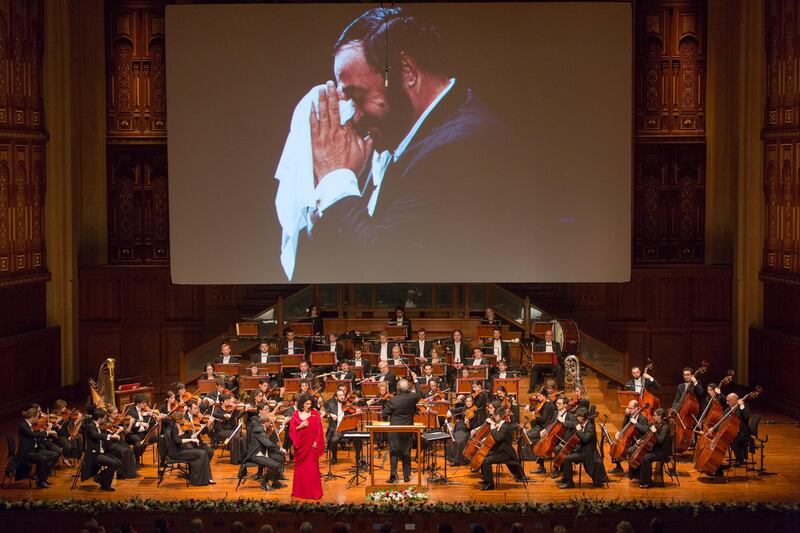Italian tenor Luciano Pavarotti lived a life as exuberant and passionate as the roles he brought to life on stage. His voice was filled with rich colour, his dramatic interpretations loaded with lofty meaning – and, indeed, such was his life.
Yet as his widow, Nicoletta Mantovani Pavarotti, reminds us, the great singer remained down to earth and true to his roots as the son of a village baker during the worldwide depression of the 1930s and its tough aftermath. His father was an amateur tenor with a remarkable voice, much like that of his son. When the two sang together, the echoing amplification of the now world-famous voice was incredible.
It was a once-in-a-lifetime experience when, in April 2005, Pavarotti came to the UAE, to appear before a huge crowd in Dubai, as the only stop in the region on his world Farewell Tour. And now there is an exclusive exhibition of Pavarotti memorabilia at the Royal Opera House Muscat, entitled Homage to Pavarotti, to mark a decade since his death.
This is no ordinary exhibition – it is an artistic expression of the character of the man and his life. When you walk into the Great Hall at the Royal Opera House Muscat, you are greeted by Pavarotti in a candid photograph, with an impish smile, his eyes twinkling and his face brimming with merriment above a perky white bow tie. Pavarotti cuts a fine figure, infused with affectionate good humour, as he puts an arm around fellow star Michael Jackson, or as he is being hugged by his wife, both laughing. These are only some of the images in a dazzling array of visuals.
Pavarotti was known for his love of silk scarves and distinctive hats. His Hermès scarves, almost works of art, were never anything but brightly coloured. Pavarotti wore them flamboyantly, as if to fire up his life offstage. And his hats, whether a straw boater with a black band in the 19th-century impressionist fashion, or a broad-brimmed fedora in the style of the 1940s, were worn with flare and suited him to a tee. The display of these signature items, along with a painting by Pavarotti, and an ornate silver box overflowing with crisp, custom-made bow ties and gorgeously patterned neckties, is simply stunning.
A little-known fact is that Pavarotti was fond of picking up a paintbrush. Flowers and coastal villages, such as the fishing village of Portofino on the Italian Riviera, were favourite subjects for his distinctive folk-art paintings, which exuded Pavarotti's zest for life. The exhibition features a signed work in acrylics, depicting a basket with flowers arranged in a bouquet so bright and plentiful that various petals reach out into the picture's old-fashioned oval frame.
The historic dimension of the exhibition is informative, as one would expect, but it is also evocative and inspiring. One of Pavarotti's best-loved roles was as Prince Calaf in Turandot, Puccini's gripping tale of love defying the odds of death. It was Pavarotti who immortalised Nessun Dorma (None Shall Sleep), the soaring aria of triumphant love emphatically proclaimed under stars that "tremble with love and with hope". The princely costume displayed is the one Pavarotti wore in Turandot at New York's Metropolitan Opera in 1997. The jacket is made of silk and velvet, understated in light charcoal grey, with restrained adornment in gold and silver appliqué. Elegant knee-high boots with long, turned-up toes signal the setting of the opera in Dynastic China.
Other wonderful period costumes, along with the white bow tie and tailcoat he would don for recitals, bring Pavarotti’s most iconic performances to life.
Also attracting special attention at the exhibition are written tributes from famous admirers, such as Princess Diana, Nelson Mandela, Frank Sinatra and Celine Dion. Those who come to the exhibition can gaze at important historical documents collected by Pavarotti, including original scores of famous operas and precious hand-written letters with their stamped envelopes from Pavarotti's favourite composers – Giacomo Puccini and Giuseppe Verdi. This display is enriched by an authentic 19th-century portrait of each composer. Gleaming in a glass case is a golden gramophone – the Emmy that was awarded to Pavarotti in 1980. Other displays feature gold records and CDs commemorating his commercial success in both the operatic and popular music domains.

An assemblage of cover pages from, Opera News, Time, Newsweek and Le Monde de la Musique, with epithets including the "Prince of tenors" and "Opera's golden tenor", brings home the worldwide stature of Pavarotti as one of the greatest singers of the modern era. In an address at the inauguration of the exhibition, Nicoletta described her husband, saying: "Larger than life in every way, his spectacular voice touched the hearts of so many, and his generosity knew no bounds". She said that the exhibition succeeded in portraying "both the man, Luciano, and the artist, Pavarotti", remarking that "the brightly coloured scarves describe a man who had always seen life in colours".
______________________
Read more:
[ The Royal Opera House Muscat announces new season ]
[ Top 10 opera destinations for 2018 ]
[ Aretha Franklin: the Queen of Soul receives a successful rebranding ]
______________________
Compliments were also expressed by Royal Opera House Muscat board member Sayyid Kamil, who said that "with the legendary power of his voice, Pavarotti opened millions of hearts and minds around the world to the sheer joy, the beauty and truth of opera". Kamil summed up The Homage to Pavarotti exhibition by saying: "We rediscover Pavarotti the man – natural and noble, as he was during his immense career.'"
The Homage to Pavarotti exhibition runs until the January 9 at the Royal Opera House Muscat, Saturdays to Thursdays, 9am to 6pm; entry is free; www.rohmuscat.org





